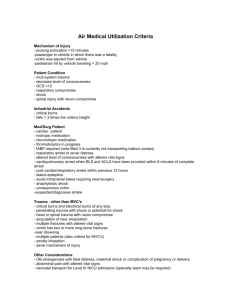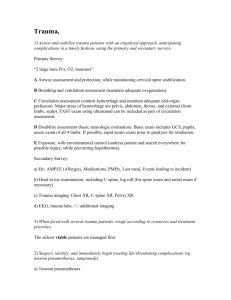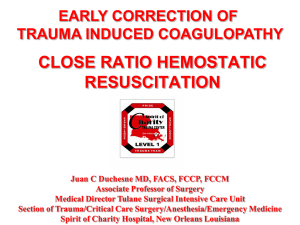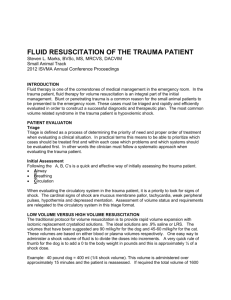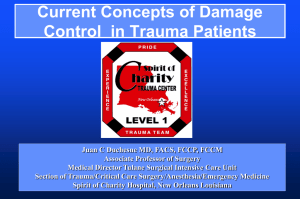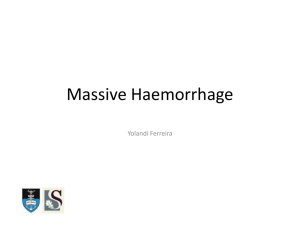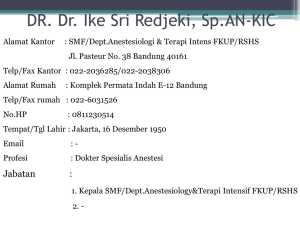Shock and Trauma Resuscitation
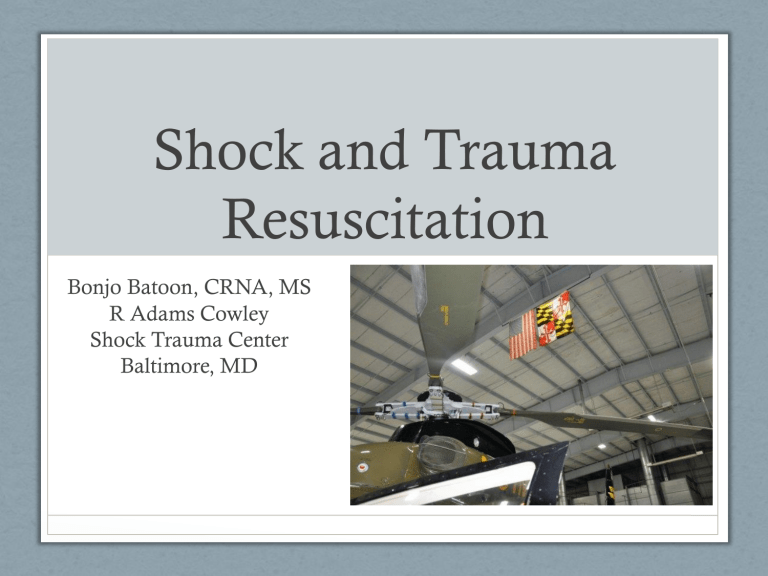
Shock and Trauma
Resuscitation
Bonjo Batoon, CRNA, MS
R Adams Cowley
Shock Trauma Center
Baltimore, MD
The Problem of Trauma
• 50% die before they reach a hospital
• Head injury major cause of death in the field/hospital
• Uncontrolled hemorrhage or MOF-related shock is the cause of death in about 40% of deaths
• 20% of hemorrhagic deaths potentially preventable
• 17% of military casualties from failed hemorrhage are potentially preventable
Dubick MA, et al. US Army Institute of Surgical Research, 2006; report # A508184
Shock by definition
• A failure of adequate oxygen delivery or utilization at the cellular level, perpetuated by cellular and humoral responses
• Prolonged shock results in a cumulative “oxygen debt”, severe metabolic derangement, and disruption of endorgan integrity and homeostasis
Shock by definition
• A state of inadequate tissue perfusion
• A cellular and end-organ disorder
• Not a disorder of the macro-circulation
• Decreased BP does not equal shock
Oxygen Debt
Types of shock
• Hemorrhagic- Most common
• Non-hemorrhagic
• Cardiogenic
• Neurogenic
• Septic
• Tension pneumothorax
• Poisoning
Signs & Symptom of Shock
• Tachycardia
• Tachypnea
• Decreased capillary refill
• Hypotension
• Narrow pulse pressure
• Altered mental status
• Cyanosis, pallor, diaphoresis
• Hypothermia
• Decreased urine output
• Absent pulse oximetry signal*
• +FAST/CT*
Classification of Shock
Lethal Triad
Coagulopathy
Acidosis
Hypothermia
More than the Lethal Trial
Hess JR, Brohi K, Dutton RP; et al. The coagulopathy of trauma: a review of mechanisms, J
Trauma 2008 654 748-754.
Resuscitation Goals
• Early recognition of the shock state
• Oxygenate and ventilate
• Restore organ perfusion
• Restore homeostasis / repay “oxygen debt”
• Stop the bleedingSurgeon’s job
• Treat coagulopathy
• Restore the circulating volume
• Continuous monitoring of the response
Components to Resuscitation
• Airway
• Breathing
• Circulation
• Exposure
Airway
• DL
• Video laryngoscopy
• AFOI
• RSI vs MRSI
• Cricoid pressure
• C-spine issues
• Surgical cricothyrotomy when all else fails
Breathing
• Secure airway most important
• Adequately oxygenate
• Monitor CO2
• Consider lower Vt in hypotensive pts
Circulation
• Adequate IV access
• Peripheral
• 16G or greater
• Know flow rates for each cathether
• Preferably central access
• IJ vs SC vs femoral
• Cordis vs double lumen catheters vs triple lumen
Exposure
• 34 ° C was the critical point at which enzyme activity slowed significantly, and at which significant alteration in platelet activity was seen. Fibrinolysis was not significantly affected at any of the measured temperatures
• Watts, Dorraine Day, et al. "Hypothermic coagulopathy in trauma: effect of varying levels of hypothermia on enzyme speed, platelet function, and fibrinolytic activity." The Journal of Trauma and
Acute Care Surgery 44.5 (1998): 846-854.
• Keeping pt warm
• Warm blood products
• Bair hugger type devices
• Warm operating room
• Basic
• Advanced
• A line
• CVP?
• PPV- FloTrac
• TEE
Monitoring
• Labs- CBC, coags, lytes,
ABGs
• POC
• Hemoque- Hgb
• iStat- lytes/gases
• ROTEM- coagulation
Clotting Dynamics
Components to Resuscitation
• Crystalloids
• Colloids
• Blood products
Crystalloids
• LR
• NS
• Plasmalyte
• Crystalloids are not and should not be the mainstay of trauma resuscitation!!
Prehospital fluids
Prehospital Fluids
Colloids
• Starches
• Coagulopathy
• Hespan max dose 20ml/kg
• Albumin
• Allergic rxs
Blood Products
• RBCs
• FFP
• Plts
• Cryoprecipitate
• Other hemostatic agents
• fVIIa, PCCs, fibrinogen concentrate
Resuscitation Strategies
• Ratio based resuscitation
• RBC;FFP; RBC:FFP:PLTs
• Laboratory based resuscitation
• Lab delays
• Lost samples
• Point of Care
• Coagulation concentrates
• ROTEM
Component Therapy
Dutton, R. P. (2012), Resuscitative strategies to maintain homeostasis during damage control surgery. Br J Surg, 99: 21–28. doi: 10.1002/bjs.7731
Damage Control
Anesthesia
Dutton, RP. Damage Control Anesthesia. Trauma Care.
2005;15:197-201.
Thank you!!
